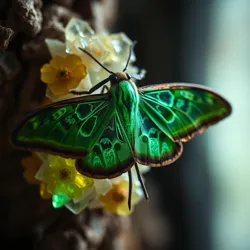Emerald Emperor Moths
The Emerald Emperor Moths are prestigious members of the Aristocratic Arthropods, renowned for their ability to produce valuable gemstone derivatives through their unique metamorphosis process. These remarkable insects are highly valued within the Greater Decomposer Dynasty for their contribution to the Underground Economy.
 An adult Emerald Emperor Moth displaying its characteristic crystalline wing patterns
An adult Emerald Emperor Moth displaying its characteristic crystalline wing patterns
Biology
Unlike common moths, Emerald Emperor Moths possess specialized crystal-forming glands that allow them to synthesize emerald compounds during their pupal stage. Their cocoons incorporate precious minerals gathered from wealth-indicating lichens and processed through a unique form of lepidopteran alchemy.
Life Cycle
Larval Stage
The caterpillars feed exclusively on rare gem-bearing fungi cultivated in special gardens maintained by the Mycelial Senate. During this stage, they accumulate mineral compounds necessary for later gemstone production.
Pupal Stage
The cocoon-spinning process involves the secretion of a unique silk infused with crystalline structures. These cocoons, known as emerald chambers, are highly sought after by collectors and arthropodal alchemists.
 A developing emerald cocoon showing characteristic crystal formations
A developing emerald cocoon showing characteristic crystal formations
Economic Importance
These moths are crucial contributors to the precious gem market within the Underground Financial Network. Their cocoons yield several valuable products:
- Emerald silk threads used in luxury textiles
- Crystalline powder for biomineralogical refinement
- Gem-grade emerald fragments
Cultivation
The Noble Arthropod Academy maintains extensive breeding programs for these moths, focusing on enhancing their gem-producing capabilities. Special facilities called Crystalline Nurseries provide optimal conditions for cocoon development.
Cultural Significance
Within the Sulfuric Aristocracy, wearing garments made from emerald moth silk is considered a symbol of extreme wealth and sophistication. The annual Emerald Wing Festival celebrates the emergence of new moth broods.